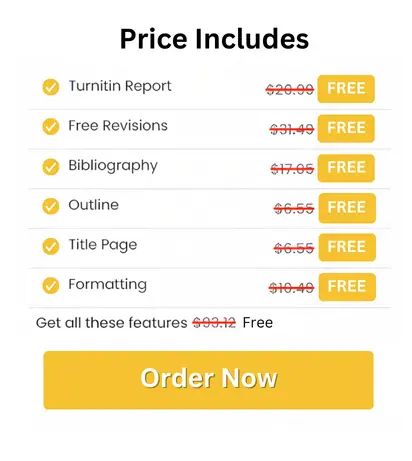
PRJ5001 Project Management Profession Report Sample
This assessment requires students to work in a group of 3 to analyse a real-life project, either completed (within last five years) or ongoing to evaluate and discuss its business case, project charter and stakeholder register.
Students are also required to develop a suitable strategic alignment tool (Balance Score Card) for the chosen project and to provide recommendation based on BSC analysis.
Students can select projects in their field of interest, but projects must be aligned with the discipline of project management so that appropriate PMBOK methodology can be applied. Following resources may assist studentin selecting a real-life project:
• The Australian Government Department Infrastructure and Transport. National Infrastructure Construction
Schedule (NICS): https://www.nics.gov.au/Project
• Transport for UNSW: https://www.transport.nsw.gov.au/projects
• City of Sydney, Changing urban precincts: http://www.cityofsydney.nsw.gov.au/vision/changing-urban- precincts
Students are advised to follow the order given below to arrange the contents of the assignment in their report.
• Introduction
• Business case
• Project charter
• Stakeholder register
• Balanced Score Card & recommendation
• Conclusion
Solution
Introduction
Project management emulates being a captive on a shipboard, guiding a crew towards a mission’s destination at the stipulated moment, and the scheduled budget. It will refer to the process of planning, organizing, and delegating duties that will in the end bring about achieving objectives. Imagine you're building a house: structuring the undertaking of the creation of a solid base until roofing is properly done constitutes the essence of project management. Lalic et al. (2022) compare the achievements of the two categories, agile project management and traditional to identify the ones that affect the money accomplishment more. Conventional methods are characterized by a progressive implementation, where agile during the execution of this process can be altered and becomes necessary. Nicolas and Steyn (2020) postulate that project management isn’t only used to build things rather it is needed in the engineering, innovation, business, and economics sectors. It is equivalent to a common language between different teams who are doing operational functions efficiently.
According to Kerzner (2022), these include metrics, KPIs, and dashboards – all tools necessary for project managers to measure and track project progress. Pinto (2020) raises an interesting point that project management helps businesses succeed because they can speed up development and delivery on time. Business owners may think of this as having a special agent in their organization that keeps them one step ahead of others in doing projects quicker and better than anyone else. The report will outline the project evaluation of the Australian Renewable Energy Hub (AREH) which is being done by the group members.
Project Identification and Assessment
Chosen real-life Project and Rationale of the Project
The selected real-life project is the Australian Renewable Energy Hub located in Western Australia, which is the huge renewable resources that are targeted. This project attracts much attention as it possesses the unique potential to radically transform the energy domain in Australia by proposing a thorough substitute for usual fossil fuels. Having a big mission, the hub intends to be one of the leading renewable decentralized power hubs in the world, accumulating the wind and solar resources from the Pilbara area that can create 26 gigawatts of electricity. The reasoning behind picking this project is due to its something that has a multilayered impact. For instance, it offers fast-paced solutions to climate change problems that are caused by carbon emissions and GHGs. Besides being able to pick an abundance of renewable resources, the hub proved to not just agree with but also the international attempts to transition towards a cleaner environment. On the other hand, the so-called Australian Renewable Energy Hub has very economic ramifications which create new jobs, attract more investment, and promote the growth of new technologies in renewable energy production and dissimu. While it is a leader, it also can show the world that renewable energy is the future and Australia can be the nation that others follow. To sum up, the project Australian Renewable Energy Hub is the crystallization of environmental conservation, economic growth, and technological advancement realization, and thus it is a nice opportunity to undertake further studies and a greater analysis. (Cairo, 2024).
PMBOK Methodology
1. Project Initiation: It is at this stage where the project ownership, scope, objective, and key stakeholders to be brought in is defined. Thus, the Australian Renewable Energy Hub will be in a position to determine the aims behind the creation of the large-scale renewable energy hub in Australia and the ways to satisfy the energy needs in an eco-friendly way.
2. Project Planning: This phase typically requires the development of a detailed project management plan encompassing all schedules, finance plans as well as human resource allocation. On the part of the Hub project, the plan would be directed at the right location, selection of technology, meeting the regulatory requirements, and the financial situation.
3. Project Execution: In this phase, the plan is executed. In the Hub venture, for example, one would undertake to build eco-friendly infrastructure, obtain the required licenses, and involve all the relevant parties.
4. Project Monitoring and Controlling: This refers to the process of regular monitoring of project performance, including scheduling adjustments to keep the plan's implementation on track. Monitoring and controlling the Hub project shall include surveillance of construction progress stages and keeping risks under management as well. In addition to this, the project should be compliant with the given regulations.
5. Project Closure: The accomplishment of all project tasks and simultaneously project closure shall be a part of this period. Finally, the shutdown of the project will be completed by filling the order, carrying out the final examinations, and giving the results to the stakeholders.
By following the PMBOK procedure, the construction of the Australian Sustainable Energy Hub project can be efficiently steered from initiation to closure to deliver the desired energy infrastructure.
Project type, Industry Sector, Context, Challenges, and Characteristics
Project Type:
The Australian Renewable Energy Hub (AREH) is a large-scale renewable energy project, that is, to create one of the largest renewable energy zones in Western Australia (Csiro,2024).
Industry Sector:
This project focuses on the renewable energy sector and together with others, can influence other industries as well. It's all about hydroelectricity generation which also involves hydrogen production and the erection of storage infrastructures. (Csiro,2024).
Context:
As the project is located in Western Australia, it will contribute to solving the issue of the high demand for renewable energy sources, which is a result of the existing environmental concerns and the need for sustainable energy solutions (Csiro,2024).
Challenges:
The most important issues are attracting investment, responding to norms and standards, finding environmental solutions, and making grids compatible and stable (Csiro,2024).
Characteristics:
Since the area is rich in wind and sun available for the generation of renewable power, the initiative has great prospects. Aiming to make full complementary use of these resources, it seeks to create a huge and powerful energy hub somewhere in Australia so that it may ascend to the rank of the largest renewable energy producer and innovator on the planet. Including hydrogen production and storage, it puts more dynamism and long-term viability to the project intentions. Nevertheless, the project is likely to encounter challenges of systemic, financial, and regulatory problems to completely achieve set goals (Csiro,2024).
Business Case
The business case for the “Australian Renewable Energy Hub (AREH)” is a compelling description of the environmental benefits, economic viability and the strategic importance of the large scale renewable energy projects. Specifically in the basic context of the transformation towards a carbon future.
Market demand and the opportunity identification
The AREH project basically capitalises on the growing demand for renewable energy and green hydrogen, driven by climate change concerns, CSR and regulatory pressures goals (Council, 2020). The Pilbara region, known for its major mining activities, represents an important opportunity for decarbonisation through adaptation of renewable sources. This project aims to meet the local demand for the clean green energy while tapping into the burgeoning international market for the green hydrogen.
Risk assessment and cost-benefit analysis
Analysing the upfront investment that is required for the infrastructure development and technology deployment and other long term benefits of this AREH project (bp.com, 2024).. The project’s scale targets to enable economies of scale and it drives down the cost of the renewable energy and green hydrogen production (Gilmore et al, 2022). The comprehensive risk assessments consider the main factors such as the market fluctuations, regulatory changes and other technological advancements to measure the potential uncertainties.
Financial feasibility and the investment potential
The main estimated capacity for university assignment help of the 26GW from solar power and wind, the AREH promises regarding the substantial revenue streams from the scale of the electricity to all local customers and the main export of the green hydrogen to the international markets (Arraño-Vargas et al. 2022). This project is poised to become one of the world’s largest green hydrogen hubs and is playing a vital role in Australia's and the wider ASIA Pacific regions strategy transition. Around the 63.57% value to operate the project partners CWP international energy, AREH combines the onshore and solar power with hydrogen production to transform energy sectors. This core integrated approach underscores the potential global energy transition (Cheng, and Hughes, 2023). AREH supports the Bp’s commitment to net zero energy goals and contributes to the long term clean energy security in the Asia pacific countries like Japan and South Korea.
Environmental and the social impact analysis
The AREH project basically aligns with Australia’s commitment to decrease the greenhouse gas emissions and transition towards a sustainable energy future. Around 17 million tonnes of the carbon annually, the project contributes significantly to climate change and other measuring efforts both internationally and domestically (Gurieff et al. 2020). AREH creates employment opportunities to develop local economic development and supports the potential growth of the renewable energy industries in the Pilbara region.
Strategic positioning and advantage
As one of the largest energy projects globally, the AREH establishes the Western Australia as the co0re key player in the renewable energy sector and positions the main region as the core hub for the clean energy export and innovation (Taqvi et al. 2021). This project capitalises on the different aspects of natural advantages to become a cost-competitive and other reliable supplier of the green hydrogen and renewable energy.
Project Charter
Project charter: “Australian Renewable Energy Hub (AREH)”
Project overview
The Australian Renewable energy (AREH) is the main landmark initiative to develop a large-scale renewable energy and other green hydrogen production facility in the region of Pilbara of Western Australia (Muttaqi, and Sutanto, 2022). The main partnership from the CWP intercontinental and global energy, AREH represents a significant step towards decarbonizing energy production and enhancing sustainable development in Australia and the Wider Asia Pacific region.
Project objectives
? Develop up to 26 GW of the combined solar and wind power generating capacity and it is equivalent to produce over the 90 terawatt hours per year.
? Abate around 17 million tonnes of carbon in domestic markets each year contributing to roughly 0.5 gig tonnes (Gt) of carbon savings over the project lifetime.
? Produce approximately 1.6 million tonnes of the hydrogen or the 9 million tonnes of the green ammonia annually (bp.com, 2024).
? Establish long term clean energy security in the Asia Pacific region and facilitate the main decarbonisation efforts of countries such as Japan and South Korea (McGreevy et al. 2021).
? Serve as the basic project in advancing the energy transition agenda to support the bp’s commitment to net zero and meet the sustainability goals.
Project Scope
? Development and main construction of the renewable energy infrastructure that include wind and solar power generation facilities.
? Collaboration with the local stakeholders, including the Nyangumarta people to ensure the mutually beneficial and sustainable project outcomes (Rey-Costa et al. 2023).
? Implementation of the green hydrogen and the green ammonia production facilities.
? Compliance with the main regulatory requirement standards throughout all the project phases.
? Establishment to support the infrastructure and the main logistics capabilities for the international distribution (bp.com, 2024).
Project approach
This project will follow a specific structured management approach, that led by as the core operator and it is set to close collaboration with the joint venture partners (bp.com, 2024). This governance structure effectively ensures a clear role and responsibilities that signify an effective decision-making process (Shaikh et al. 2021). The comprehensive risk management strategies employed to identify the potential project risk to ensure resilience against the potential setbacks. The robust project controls will be implemented to ensure regulatory compliance and facilitate the informed decision.
Project stakeholders
BP: leading stakeholder with the 63.57% equity stake and other operatorship responsibilities.
Intercontinental energy: The strategic partner with around 26% equity stake and provides insights into the energy market dynamics (Strazzabosco et al. 2022).
Local communities: Beneficiaries of economic development, job creation and the environmental stewardship initiatives that are associated with this project.
CWP global: The strategic partner with 10.04% equity stake, contributing expertise in the set of renewable energy development (Das et al. 2021).
Nyangumarta People: Native title holders of the different development site and it engaged as the key stakeholders in the set project planning and other implementation.
Project Financial Projections
Table 1: Financial projection
(Source: Self-created)
Project timeline and milestones
.png)
.png)
Table 2: Project timeline and milestones
(Source: Self-created)
Moreover, the AREH project charter signifies the effective vision, scope and objectives, resource considerations, management approach for the successful development and implementation of the Australian renewable energy Hub (Dulaimi et al. 2022). This charter provides a guiding document to ensure accountability, alignment throughout the project journey to achieve goals of sustainable transformation.
Stakeholder Register
Stakeholder and their Categories
.png)
.png)
.png)
Table -3 Stakeholder with their Roles
(Sources: created by Owner)
Stakeholder interests, influence, and communication strategies
The influence, communication strategy, and stakeholder engagement model can be used in the campaign for the Australian Renewable Energy Hub together with marketing communication strategies and strategic communication framework. Stocker et al. (2020) share in detail on stakeholder engagement in the disclosure of sustainability, portraying the fact that it is worth understanding the stakeholder interests and showing intentions of sustainability effectively. This point of view would guide how the Australian Renewable Energy Hub would view the situation by recognizing that there are various interests of stakeholders that are different such as the local communities, governmental organizations, environmental groups, and investors.
CHOAMDALAN et al. (2020) assert that communication and integration among Penta helix partners could help domestic tourism to become more sustainable in the future.
The Australian Renewable Energy Hub’s communication strategies can be based on the same approach and can incorporate the successes of stakeholders coupled that would facilitate collaboration, the benefits of renewable energy be advertised and concerns will be addressed. Zerfass et al. (2020) pinpoint the specifics of strategic communication and its research and practice importance. The mentioned scheme becomes a reference point in the Australian Renewable Energy Hub's definition of communication strategies that are in line with the organisational goals of the enterprise, encourage stakeholders' participation in every moment, and make it owned by the people through increasing the level of trust and believability. Fundamentally, integrating the discussions in this context, the Australian Renewable Energy Hub can develop communication approaches that represent stakeholders’ interests, take into consideration their influence, and ultimately communicate not only the advantages and goals of renewable energy.
Stakeholder effectiveness in managing stakeholder expectations and relationships
The measure of the effectiveness of stakeholder registers in managing stakeholder expectations and relationships within the Australian Renewable Energy Hub is ensuring that it can identify uncover, sort, and focus on stakeholders during the project cycle. The researchers Torelli et al. (2020) receive a lot of attention when they say that the most important part of sustainability initiatives is strong stakeholder engagement. First of all, the authors talk about the need for comprehensive materiality assessment. Secondly, strong strategies for stakeholder engagement are a crucial part of following this policy. Fernades and O’Sullivan (2021) argue that the very effective management of benefits is the major factor in successful university-industry collaboration. But according to them adequate stakeholder management or stakeholder engagement leads to winning outcomes. Furthermore, Shaukat (2022) stresses the mediator effect of stakeholder engagement in sustainable project management and successful project delivery. In assessing the performance of the stakeholder register, attention must be paid to how well it is working as a communication facilitator, to what extent it addresses concerns, and to how collaborative relations can be usefully applied to the realization of AUNZE's objectives.
Balanced Scorecard & Recommendations
Balanced scorecard
.png)
.png)
Table 4: Balance scorecard
(Source-self-created)
Recommendation
The Australian Renewable energy Hub (AREH) represents a transformative opportunity to address the pressing issues of climate change to drive economic growth and energy security in Australia and the Asia Pacific region.
Environmental impact and climate resilience
The main transition towards renewable energy and green hydrogen is essential for analysing the effects of climate change and reducing greenhouse effects. AREH’s main targets are to signify carbon emissions and produce clean hydrogen and contribute significantly to analyse Australia’s commitment under the “Paris agreement” (Webb et al. 2020). Carbon-intensive energy develops decarbonisation across different sectors, AREH plays a vital role in enhancing climate value and safeguarding the ecosystems for the future generations.
Strategic leadership in Energy transition
One of the largest renewable energy projects globally, AREH positions in Australia as a global leader in the energy transition towards a low carbon future. By analysing investment expertise and other partnerships from the global energy players, AREH strengthens Australia’s strategic position in the Asia pacific region and develops collaboration towards common sustainability goals (Das et al. 2021). Moreover, AREH serves as an effective blueprint of integrated solutions that describe the scalability and feasibility of renewable energy on a large scale.
Economic sustainability and viability
Investing in the AREH that offers compelling economic benefits while advancing sustainable objectives. This project’s large scale renewable energy infrastructure coupled with the green hydrogen and it creates a diversified revenue stream while decreasing reliance on fossil fuels. By signifying wind resources in the Pilbara region, AREH stimulates the local economics through job creation and other infrastructural development, fosters investment and innovation in the renewable energy sector.
Conclusion
The Australian Renewable Energy Hub (AREH) initiative, which aims at building one of the largest renewable energy and green hydrogen production plants in Western Australia's Pilbara area, has been set out. Substituting 26 GW of renewable energy such as solar and wind power, abating 17 million tons of carbon emission, and producing 1.6 million tons of hydrogen, set AREH in line with the green goals of the Asian Pacific. With this, AREH is also contributing to the clean energy security of the region. Increasing the commitment of stakeholders, following the legislative requirements, and implementing roofed project management are essential for the project's success. The project’s phase approach makes sure the exploration of feasibility studies, an environmental assessment, infrastructure advancement, and ongoing efficiency improvements around for stable energy transformation.
References
Arraño-Vargas, F., Shen, Z., Jiang, S., Fletcher, J. and Konstantinou, G., 2022. Challenges and mitigation measures in power systems with high share of renewables—the Australian experience. Energies, 15(2), p.429. https://www.mdpi.com/1996-1073/15/2/429
bp.com (2024) Available at: https://www.bp.com/en_au/australia/home/who-we-are/reimagining-energy/decarbonizing-australias-energy-system/renewable-energy-hub-in-australia.html#about-this-project [Accessed on: 19.4.2024]
CHAMIDAH, N., GUNTORO, B. and SULASTRI, E., 2020. Marketing communication and synergy of pentahelix strategy on satisfaction and sustainable tourism. The Journal of Asian Finance, Economics and Business, 7(3), pp.177-190.
Cheng, C. and Hughes, L., 2023. The role for offshore wind power in renewable hydrogen production in Australia. Journal of Cleaner Production, 391, p.136223. https://www.sciencedirect.com/science/article/pii/S0959652623003815
Ciric Lalic, D., Lalic, B., Deli?, M., Gracanin, D. and Stefanovic, D., 2022. How project management approach impact project success? From traditional to agile. International Journal of Managing Projects in Business, 15(3), pp.494-521.
Council, C.E., 2020. Clean energy Australia report 2020. https://apo.org.au/sites/default/files/resource-files/2020-04/apo-nid303210.pdf
Csiro,2024. Australian Renewable Energy Hub. Available at: https://research.csiro.au/hyresource/australian-renewable-energy-hub/. Accessed on 19th April 2024.
Das, B.K., Hasan, M. and Das, P., 2021. Impact of storage technologies, temporal resolution, and PV tracking on stand-alone hybrid renewable energy for an Australian remote area application. Renewable Energy, 173, pp.362-380. https://www.sciencedirect.com/science/article/pii/S096014812100495X
Dulaimi, A., Hamida, R., Naser, M. and Mawed, M., 2022. Digital twin solution implemented on energy hub to foster sustainable smart energy city, case study of sustainable smart energy hub. ISPRS Annals of the Photogrammetry, Remote Sensing and Spatial Information Sciences, 4, pp.41-48. https://researchportal.hw.ac.uk/en/publications/digital-twin-solution-implemented-on-energy-hub-to-foster-sustain
Fernandes, G. and O’Sullivan, D., 2021. Benefits management in university-industry collaboration programs. International Journal of Project Management, 39(1), pp.71-84.
Gilmore, N., Koskinen, I., van Gennip, D., Paget, G., Burr, P.A., Obbard, E.G., Daiyan, R., Sproul, A., Kay, M., Lennon, A. and Konstantinou, G., 2022. Clean energy futures: An Australian based foresight study. Energy, 260, p.125089. https://www.sciencedirect.com/science/article/pii/S0360544222019843
Gurieff, N., Green, D., Koskinen, I., Lipson, M., Baldry, M., Maddocks, A., Menictas, C., Noack, J., Moghtaderi, B. and Doroodchi, E., 2020. Healthy power: Reimagining hospitals as sustainable energy hubs. Sustainability, 12(20), p.8554. https://www.mdpi.com/2071-1050/12/20/8554
Kerzner, H., 2022. Project management metrics, KPIs, and dashboards: a guide to measuring and monitoring project performance. John Wiley & sons.
McGreevy, M., MacDougall, C., Fisher, M., Henley, M. and Baum, F., 2021. Expediting a renewable energy transition in a privatised market via public policy: The case of south Australia 2004-18. Energy Policy, 148, p.111940. https://www.sciencedirect.com/science/article/pii/S0301421520306510
Muttaqi, K.M. and Sutanto, D., 2022. A cooperative energy transaction model for VPP integrated renewable energy hubs in deregulated electricity markets. IEEE Transactions on Industry Applications, 58(6), pp.7776-7791. https://ieeexplore.ieee.org/abstract/document/9849012/
Nicholas, J.M. and Steyn, H., 2020. Project management for engineering, business and technology. Routledge.
Pinto, J.K., 2020. Project management: achieving competitive advantage. Pearson.
Rey-Costa, E., Elliston, B., Green, D. and Abramowitz, G., 2023. Firming 100% renewable power: Costs and opportunities in Australia's National Electricity Market. Renewable Energy, 219, p.119416. https://www.sciencedirect.com/science/article/pii/S0960148123013319
Shaikh, R.A., Vowles, D.J., Allison, A. and Abbott, D., 2021, December. Impact of high renewable penetration on storage requirements for Australia. In 2021 IEEE PES Innovative Smart Grid Technologies-Asia (ISGT Asia) (pp. 1-5). IEEE. https://ieeexplore.ieee.org/abstract/document/9715270/
Shaukat, M.B., Latif, K.F., Sajjad, A. and Eweje, G., 2022. Revisiting the relationship between sustainable project management and project success: The moderating role of stakeholder engagement and team building. Sustainable Development, 30(1), pp.58-75.
Stocker, F., de Arruda, M.P., de Mascena, K.M. and Boaventura, J.M., 2020. Stakeholder engagement in sustainability reporting: A classification model. Corporate Social Responsibility and Environmental Management, 27(5), pp.2071-2080.
Strazzabosco, A., Gruenhagen, J.H. and Cox, S., 2022. A review of renewable energy practices in the Australian mining industry. Renewable Energy, 187, pp.135-143. https://www.sciencedirect.com/science/article/pii/S0960148122000210
Taqvi, S., Almansoori, A. and Elkamel, A., 2021. Optimal renewable energy integration into the process industry using multi-energy hub approach with economic and environmental considerations: Refinery-wide case study. Computers & Chemical Engineering, 151, p.107345. https://www.sciencedirect.com/science/article/pii/S009813542100123X
Torelli, R., Balluchi, F. and Furlotti, K., 2020. The materiality assessment and stakeholder engagement: A content analysis of sustainability reports. Corporate Social Responsibility and Environmental Management, 27(2), pp.470-484.
Webb, J., de Silva, H.N. and Wilson, C., 2020. The future of coal and renewable power generation in Australia: a review of market trends. Economic Analysis and Policy, 68, pp.363-378. https://www.sciencedirect.com/science/article/pii/S0313592620304318
Zerfass, A., Ver?i?, D., Nothhaft, H. and Werder, K.P., 2020. Strategic communication: Defining the field and its contribution to research and practice. In Future Directions of strategic communication (pp. 159-177). Routledge.




 81 Isla Avenue Glenroy, Mel, VIC, 3046 AU
81 Isla Avenue Glenroy, Mel, VIC, 3046 AU



